#Environmental resilience
Text
The Dance of Weather: How Trees and Forests Shape Our World

View On WordPress
#afforestation#air movement#atmospheric science#canopy cover#climate#climate change#climate cooling#climate research#climate stability#cloud cover#cloud formation#cooling effect#dew formation#Dr. Paul Schreiber#drought prevention#ecological balance#Ecosystem#ecosystem health#environmental balance#environmental impact#environmental resilience#evaporation#forest benefits#Forest Canopy#forest dynamics#Forest Ecology#Forest Health#forest influence#forest management#forest microclimate
0 notes
Text
As relentless rains pounded LA, the city’s “sponge” infrastructure helped gather 8.6 billion gallons of water—enough to sustain over 100,000 households for a year.
Earlier this month, the future fell on Los Angeles. A long band of moisture in the sky, known as an atmospheric river, dumped 9 inches of rain on the city over three days—over half of what the city typically gets in a year. It’s the kind of extreme rainfall that’ll get ever more extreme as the planet warms.
The city’s water managers, though, were ready and waiting. Like other urban areas around the world, in recent years LA has been transforming into a “sponge city,” replacing impermeable surfaces, like concrete, with permeable ones, like dirt and plants. It has also built out “spreading grounds,” where water accumulates and soaks into the earth.
With traditional dams and all that newfangled spongy infrastructure, between February 4 and 7 the metropolis captured 8.6 billion gallons of stormwater, enough to provide water to 106,000 households for a year. For the rainy season in total, LA has accumulated 14.7 billion gallons.
Long reliant on snowmelt and river water piped in from afar, LA is on a quest to produce as much water as it can locally. “There's going to be a lot more rain and a lot less snow, which is going to alter the way we capture snowmelt and the aqueduct water,” says Art Castro, manager of watershed management at the Los Angeles Department of Water and Power. “Dams and spreading grounds are the workhorses of local stormwater capture for either flood protection or water supply.”
Centuries of urban-planning dogma dictates using gutters, sewers, and other infrastructure to funnel rainwater out of a metropolis as quickly as possible to prevent flooding. Given the increasingly catastrophic urban flooding seen around the world, though, that clearly isn’t working anymore, so now planners are finding clever ways to capture stormwater, treating it as an asset instead of a liability. “The problem of urban hydrology is caused by a thousand small cuts,” says Michael Kiparsky, director of the Wheeler Water Institute at UC Berkeley. “No one driveway or roof in and of itself causes massive alteration of the hydrologic cycle. But combine millions of them in one area and it does. Maybe we can solve that problem with a thousand Band-Aids.”
Or in this case, sponges. The trick to making a city more absorbent is to add more gardens and other green spaces that allow water to percolate into underlying aquifers—porous subterranean materials that can hold water—which a city can then draw from in times of need. Engineers are also greening up medians and roadside areas to soak up the water that’d normally rush off streets, into sewers, and eventually out to sea...
To exploit all that free water falling from the sky, the LADWP has carved out big patches of brown in the concrete jungle. Stormwater is piped into these spreading grounds and accumulates in dirt basins. That allows it to slowly soak into the underlying aquifer, which acts as a sort of natural underground tank that can hold 28 billion gallons of water.
During a storm, the city is also gathering water in dams, some of which it diverts into the spreading grounds. “After the storm comes by, and it's a bright sunny day, you’ll still see water being released into a channel and diverted into the spreading grounds,” says Castro. That way, water moves from a reservoir where it’s exposed to sunlight and evaporation, into an aquifer where it’s banked safely underground.
On a smaller scale, LADWP has been experimenting with turning parks into mini spreading grounds, diverting stormwater there to soak into subterranean cisterns or chambers. It’s also deploying green spaces along roadways, which have the additional benefit of mitigating flooding in a neighborhood: The less concrete and the more dirt and plants, the more the built environment can soak up stormwater like the actual environment naturally does.
As an added benefit, deploying more of these green spaces, along with urban gardens, improves the mental health of residents. Plants here also “sweat,” cooling the area and beating back the urban heat island effect—the tendency for concrete to absorb solar energy and slowly release it at night. By reducing summer temperatures, you improve the physical health of residents. “The more trees, the more shade, the less heat island effect,” says Castro. “Sometimes when it’s 90 degrees in the middle of summer, it could get up to 110 underneath a bus stop.”
LA’s far from alone in going spongy. Pittsburgh is also deploying more rain gardens, and where they absolutely must have a hard surface—sidewalks, parking lots, etc.—they’re using special concrete bricks that allow water to seep through. And a growing number of municipalities are scrutinizing properties and charging owners fees if they have excessive impermeable surfaces like pavement, thus incentivizing the switch to permeable surfaces like plots of native plants or urban gardens for producing more food locally.
So the old way of stormwater management isn’t just increasingly dangerous and ineffective as the planet warms and storms get more intense—it stands in the way of a more beautiful, less sweltering, more sustainable urban landscape. LA, of all places, is showing the world there’s a better way.
-via Wired, February 19, 2024
#california#los angeles#water#rainfall#extreme weather#rain#atmospheric science#meteorology#infrastructure#green infrastructure#climate change#climate action#climate resilient#climate emergency#urban#urban landscape#flooding#flood warning#natural disasters#environmental news#climate news#good news#hope#solarpunk#hopepunk#ecopunk#sustainability#urban planning#city planning#urbanism
14K notes
·
View notes
Text









"Disaster Taxon," poem assembled using text from Wikipedia articles
#wikipedia poem#wikipedia poetry#climate grief#grief#environmental grief#resilience#climate change#gilgamesh#flood narrative#post apocalyptic#poetry#my writing#wikipedia poems#weeds#plantarchy#mass extinction#dandelion#utnapishtim
13K notes
·
View notes
Text
"Starting this month [June 2024], thousands of young people will begin doing climate-related work around the West as part of a new service-based federal jobs program, the American Climate Corps, or ACC. The jobs they do will vary, from wildland firefighters and “lawn busters” to urban farm fellows and traditional ecological knowledge stewards. Some will work on food security or energy conservation in cities, while others will tackle invasive species and stream restoration on public land.
The Climate Corps was modeled on Franklin D. Roosevelt’s Civilian Conservation Corps, with the goal of eventually creating tens of thousands of jobs while simultaneously addressing the impacts of climate change.
Applications were released on Earth Day, and Maggie Thomas, President Joe Biden’s special assistant on climate, told High Country News that the program’s website has already had hundreds of thousands of views. Since its launch, nearly 250 jobs across the West have been posted, accounting for more than half of all the listed ACC positions.
“Obviously, the West is facing tremendous impacts of climate change,” Thomas said. “It’s changing faster than many other parts of the country. If you look at wildfire, if you look at extreme heat, there are so many impacts. I think that there’s a huge role for the American Climate Corps to be tackling those crises.”
Most of the current positions are staffed through state or nonprofit entities, such as the Montana Conservation Corps or Great Basin Institute, many of which work in partnership with federal agencies that manage public lands across the West. In New Mexico, for example, members of Conservation Legacy’s Ecological Monitoring Crew will help the Bureau of Land Management collect soil and vegetation data. In Oregon, young people will join the U.S. Department of Agriculture, working in firefighting, fuel reduction and timber management in national forests.
New jobs are being added regularly. Deadlines for summer positions have largely passed, but new postings for hundreds more positions are due later this year or on a rolling basis, such as the Working Lands Program, which is focused on “climate-smart agriculture.” ...
On the ACC website, applicants can sort jobs by state, work environment and focus area, such as “Indigenous knowledge reclamation” or “food waste reduction.” Job descriptions include an hourly pay equivalent — some corps jobs pay weekly or term-based stipends instead of an hourly wage — and benefits. The site is fairly user-friendly, in part owing to suggestions made by the young people who participated in the ACC listening sessions earlier this year...
The sessions helped determine other priorities as well, Thomas said, including creating good-paying jobs that could lead to long-term careers, as well as alignment with the president’s Justice40 initiative, which mandates that at least 40% of federal climate funds must go to marginalized communities that are disproportionately impacted by climate change and pollution.
High Country News found that 30% of jobs listed across the West have explicit justice and equity language, from affordable housing in low-income communities to Indigenous knowledge and cultural reclamation for Native youth...
While the administration aims for all positions to pay at least $15 an hour, the lowest-paid position in the West is currently listed at $11 an hour. Benefits also vary widely, though most include an education benefit, and, in some cases, health care, child care and housing.
All corps members will have access to pre-apprenticeship curriculum through the North America’s Building Trades Union. Matthew Mayers, director of the Green Workers Alliance, called this an important step for young people who want to pursue union jobs in renewable energy. Some members will also be eligible for the federal pathways program, which was recently expanded to increase opportunities for permanent positions in the federal government...
“To think that there will be young people in every community across the country working on climate solutions and really being equipped with the tools they need to succeed in the workforce of the future,” Thomas said, “to me, that is going to be an incredible thing to see.”"
-via High Country News, June 6, 2024
--
Note: You can browse Climate Corps job postings here, on the Climate Corps website. There are currently 314 jobs posted at time of writing!
Also, it says the goal is to pay at least $15 an hour for all jobs (not 100% meeting that goal rn), but lots of postings pay higher than that, including some over $20/hour!!
#climate corps#climate change#climate activism#climate action#united states#us politics#biden#biden administration#democratic party#environment#environmental news#climate resilience#climate crisis#environmentalism#climate solutions#jobbs#climate news#job search#employment#americorps#good news#hope
1K notes
·
View notes
Text
In response to last year’s record-breaking heat due to El Niño and impacts from climate change, Indigenous Zenù farmers in Colombia are trying to revive the cultivation of traditional climate-resilient seeds and agroecology systems.
One traditional farming system combines farming with fishing: locals fish during the rainy season when water levels are high, and farm during the dry season on the fertile soils left by the receding water.
Locals and ecologists say conflicts over land with surrounding plantation owners, cattle ranchers and mines are also worsening the impacts of the climate crisis.
To protect their land, the Zenù reserve, which is today surrounded by monoculture plantations, was in 2005 declared the first Colombian territory free from GMOs.
#good news#science#environmentalism#indigenous people#indigenous agriculture#zenù#agroecology#nature#environment#farming#sustainable farming#climate resilience#climate change#columbia
56 notes
·
View notes
Text
Repost from @sim_bookstagrams_badly:
HOW TO SAVE THE WORLD!!! Liberals, suspend your disbelief for just a mo, challenge.
Support the Refaat Alareer camp organized by @thesameerproject, more info in bio
#degrowth#anti capitalism#public transit#ecofriendly#environmental activism#environment#climate change#climate crisis#climate justice#climate resilience#food justice#farming#urban planning#cities#survival#housing#food not lawns
29 notes
·
View notes
Text

External activism is incredibly important but so is internal activism. How can we change the world around us if we can't treat ourselves with compassion? With the constant struggle of this work, there are part of you that deserve just as much attention and care.
-qbv
#queerbrownvegan#sustainability#climate change#environmentalism#social justice#environment#climate crisis#environmental justice#activism#intersectional environmentalism#wellbeing#resilience#mental health
91 notes
·
View notes
Text







Julia Hill, 22, climbed a tree in California and spent more than two years on it to save it from being cut down. 🌳🌎🌿
#JuliaHill#TreeSitter#Activism#Environmentalism#SaveTheTrees#California#TreeProtection#NatureConservation#Inspiration#Dedication#EnvironmentalActivism#ForestProtection#ClimateAction#SaveOurPlanet#Courage#Resilience#EnvironmentalHero#TreeHugger#NatureLover#ConservationEfforts#ChangeMakers
3 notes
·
View notes
Text
Season One: Must Solarpunk Should?
Season one is here! Or, well, it's uploaded to the feeds we own now, so listeners can find it much more easily. We're testing out backdating our season one episodes, so stay tuned! Here's the original description:
"In this soft-launch of Solarpunk Presents, the companion podcast to Solarpunk Futures, hosts and Solarpunk Magazine nonfiction editors @arielkroon and @xtinadlr tackle the question of “Must Solarpunk Should”? This is a dilemma that unconsciously or consciously comes through in a lot of the nonfiction submissions that we receive in our slush pile, and we have Thoughts about it. So many…

View On WordPress
#climate action#climate activism#community#dictates#editing#environmentalism#fiction writing#lifestyle#magazine editing#manifestos#non-fiction#resilience#solarpunk#solarpunk fiction#solarpunk presents podcast#sustainability#writing
4 notes
·
View notes
Text
Basalt Fiber Reinforcement in Construction: A Sustainable Paradigm Shift
Introduction
In the contemporary construction landscape, a notable shift towards sustainable and eco-friendly building materials is underway. Among the alternatives gaining prominence is basalt fiber reinforcement, positioning itself as a compelling substitute for traditional steel reinforcement. This transition is fueled by a collective desire to reduce environmental impact and elevate the…

View On WordPress
#alternative to steel reinforcement#basalt fiber applications#basalt fiber properties#Basalt fiber reinforcement#basalt mesh in concrete#BFRP composites#construction industry sustainability#corrosion-resistant materials#durability in construction#eco-friendly building#environmental impact of construction#future of construction materials.#green building practices#lightweight construction materials#seismic resilience in buildings#steel replacement in construction#strength-to-weight ratio#Sustainable Construction Materials#sustainable structural design#thermal insulation in construction
2 notes
·
View notes
Text
wake me up when everything stops going to shit
#i'm not having a good time rn#got confirmation the water damage is back and NEW and coming from probably the neighbor's unit#strong possibility that we'll have to redo at least a third of the repair we just fucking finished#which we can't afford#and im just...#i'm a camel waiting for that last final straw because i can FEEL that the next bs that hits is gonna break me#i have negative resiliency rn#have for a while#and in context that makes sense#but it also sucks ass because right as i get out of my own personal hellscape the entire world goes further into global ones#and i have no capacity to cope because i used it all up already#i don't even know if i have the ABILITY to regain resiliency anymore or if i used that all up too#and none of it is the kind of shit therapy will help with#because the problems hitting me now are all *waves at the state of the world rn*#economic political environmental#not even getting into the shit going on with my health lately#like yes the hospital saved my life but i picked up AT LEAST two new infections that have LINGERED while i was there
2 notes
·
View notes
Text
Guardians of the Flow

View On WordPress
#advocacy#Aquatic Ecosystems#Biodiversity Preservation#Chappell Marsh#City planning#clean water#Climate Resilience#Community Engagement#Community Monitoring#Community Resilience#Community Sustainability#conservation awareness#conservation initiatives#Conservation Organizations#Conservation Partnerships#Conservation Practices#conservation programs#Conservation Strategies#cultural significance#Earth&039;s Water Resources#ecological balance#ecosystem health#Ecosystem Preservation#environmental awareness#Environmental Citizenship#Environmental Education#environmental impact#Environmental Monitoring#Environmental Protection#environmental resilience
0 notes
Photo

A lot of trees in this swamp laid down their lives in the last hurricane....... by which I mean they are Laying On The Ground, and also Still Very Much Alive. See all those new branches, the red shoots going straight up?
I think the swamp muck is so wet that even with half their roots in the air, they’re still getting enough water to carry on.
#ecology#red maple#trees#resilience#natural disturbance#environmental science#swamp#post-hurricane ecosystems#Hurricane Ian#spring#new leaves
4 notes
·
View notes
Text
Fortifying Your Inner Fortress: The Transformative Power of Emotional Resilience in a Stressful World
In the tapestry of modern life, environmental stressors weave an intricate and often overwhelming pattern. From the relentless hum of urban landscapes to the digital deluge of information, our senses are constantly bombarded with stimuli that can trigger anxiety, frustration, and a sense of being perpetually on edge. While we cannot always control the external forces that buffet us, we can…
#coping skills#emotional resilience#environmental stressors#mental health#mindfulness#stress management
0 notes
Text
Putting a price on soils: can farmers benefit?
Healthy soils do much more than produce food. They perform a multitude of vital functions, like filtering water, supporting biodiversity, and even protecting the planet from climate change. Just as the environmental costs of intensive farming never factor into the price of food, farmers who build soil health are rarely compensated for the ecosystem services they provide. As a result of these…
#agricultural subsidies#agriculture sustainability#agrifood system#carbon markets#carbon measurement#carbon sequestration#climate change#climate mitigation#Climate resilience#Climate-Smart Agriculture#conservation agriculture#ecosystem services#environmental costs#environmental incentives#fertilizer subsidies#Food security#greenhouse gas emissions#healthy soils#inorganic fertilizers#intensive farming#organic fertilizers#Payment for Ecosystem Services#PES#public policy in agriculture#regenerative agriculture#soil biodiversity#soil carbon#soil carbon sinks#soil conservation#SOIL FERTILITY
0 notes
Text
The study, published in Ecology and Evolution, explores forests that experience "cold-air pooling," a phenomenon where cold air at higher elevations drains down into lower-lying valleys, reversing the expected temperatures—warm at the bottom, cold at the top—that typically occurs in mountainous areas. That is, the air temperature drops with descent from mountain to valley.
"With temperature inversions, we also see vegetation inversions," says lead study author and former UVM postdoctoral researcher Melissa Pastore. "Instead of finding more cold-preferring species like spruce and fir at high elevations, we found them in lower elevations—just the opposite of what we expect."
And the effect on these ecosystems is substantial: "This cold-air pooling is fundamentally structuring the forest," says study co-author and UVM professor Carol Adair.
This insight "can help forest managers prioritize and protect areas with frequent and strong cold-air pooling to preserve cold-loving species as the climate warms," says Adair.
The researchers looked at three forested sites in New England, ranging from the shallow, crater-like Nulhegan Basin of Vermont's Northeast Kingdom, to the higher peaks and deeper valleys of the Green Mountains, over two years. They collected data on the types of trees present across elevation transects and monitored temperature hourly.
The researchers found that, far from being the occasional nighttime, seasonal phenomenon it's historically been thought to be, cold-air pooling happens frequently, year-round, well into daylight hours, Adair says. The phenomenon occurred at every site they studied, but was strongest at the site with the shallowest elevation change.
Refuge in a changing climate
Locations experiencing this phenomenon might prove essential to conservation efforts aimed at preserving cold-adapted species, even as the larger climate warms, Pastore notes. "These cold-air-pooling areas could be valuable targets for small areas that provide a refuge from climate change; they're areas that might be buffered from, or even decoupled from, climate change, and they're harboring cold-adapted species that we know are vulnerable."
She adds that conserving such locations may provide enough time for species to adapt to climate change by either migrating, or by mixing genes with neighbors to assume traits needed for survival in a hotter world.
In this way, Pastore says, "These pockets of cold habitat can act as steppingstones for some species—can buy them that time."
Conserving such locations may have practical applications, as well, says Adair, "including carbon storage and small-scale recreational opportunities," adding that cold-loving coniferous tree communities tend to store more carbon than deciduous trees, and forest soils may also hold onto moisture longer—important during periods of extreme rain.
Cold-air pooling has been historically and anecdotally observed elsewhere, Adair says, but this study is the first to quantify it to this degree across many sites beneath the forest canopy, and more research is planned to explore its temporal and geographic extent.
Cold-air pooling is not a panacea, Pastore warns. These forests are "still going to warm—I definitely don't want to say these are complete safe havens, because climate change will happen there, too—but it might be slower, and maybe species that might otherwise disappear in a warmer climate will remain longer in these locations."
The research is highly relevant in a changing climate, as ecologists seek to model what may happen to species that require cold conditions. "If you don't have this process in your model," Adair says, "you're going to miss that there are these areas where cold-loving species can persist and are persisting."
The work has been a hopeful change of pace, Adair says. "I'm excited about the fact that this is good news, in a way. These areas can help cold-adapted species persist." She adds, "A lot of my research is telling people why bad things are happening, so this is nice. It's not all good news, but it's some good news. These places exist. We can use them. They're important. They're clearly structuring forests."
#good news#global climate change#climate crisis#environmentalism#science#environment#forests#climate resilience#nature#conservation#climate change#animals#cold forests#climate change adaptation#climate change resiliency
30 notes
·
View notes